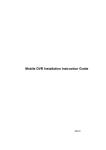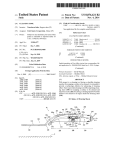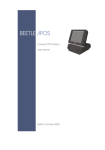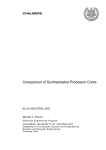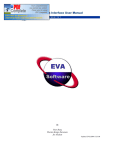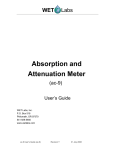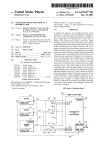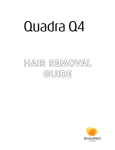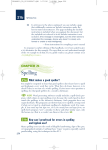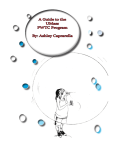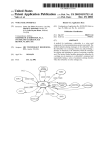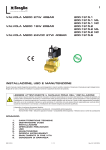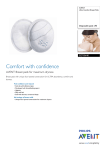Download Absorbent Articles Bearing Graphics Visually Coordinated To Clothing
Transcript
US 20120029457Al (19) United States (12) Patent Application Publication (10) Pub. N0.: US 2012/0029457 A1 Mason et al. (54) (43) Pub. Date: ABSORBENT ARTICLES BEARING Feb. 2, 2012 Publication Classi?cation GRAPHICS VISUALLY COORDINATED TO CLOTHING (76) Inventors: (51) Int. Cl. A61F 13/49 (2006.01) Beth Goldman Mason, Cincinnati, OH (US); George Christopher Dobrin’ Mason, OH (Us); Rachel (21) Appl. N0.: _ (22) F1led: (57) Jun. 9, 2011 . . Related U's' Apphcatlon Data (60) (52) US. Cl. ................................................. .. 604/385.01 Eden Walther, Union, KY (U S) 13/156,594 Provisional application No, 61/368,252, ?led on Jul' 27, 2010. ABSTRACT In one aspect, the invention relates generally to absorbent articles having graphics disposed upon them. The graphics are visually coordinated to clothing. The clothing may be an article of clothing and/or a line of clothing. Patent Application Publication Feb. 2, 2012 Sheet 1 0f 11 2 c @ 3 9 m E 8 5 i : w G v c m r i u m w x v B5&953 US 2012/0029457 A1 HEBG2. 3mm 2651Mm9.' 6 al mM3wEU:ct5B2QwE8 > 5wE5p82mm:b n0ms > m5BU5wQ9Ec?L0Q.mEo65Z 99:EU6Ew2::Ue86o2Emn: @255mm9.:0 2:2m5w“p5:Ebm9n05s2w a Patent Application Publication Feb. 2, 2012 Sheet 2 0f 11 US 2012/0029457 A1 Select Inspiration Theme l Scan Available Design Elements into Computer l Create a Layout: Adobe Creative Suite or similar program Create Vector Images based on SCanned 0r draWn images the scanned image or place scanned image maybe stepped and repeated to ?ll the required template space. l Manipulate Artwork to add 3D effects and details such as shadows, stitching, pockets, belts, belt loops, snaps, buttons, button holes, etc. l Graphics are rendered as a 3D image or digitally printed for consumer testing Make any desired adjustments Color separation and print suitability adaptations based on press ?ngerprinting information l Flexographic Plates are manufactured Patent Application Publication Feb. 2, 2012 Sheet 3 0f 11 US 2012/0029457 A1 Preliminary Printing trial to check color builds and color match Make hand-made absorbent articles to con?rm color and layout in context of the absorbent article Check also for ink adhesion and colorfastness Check for safety, appearance, and Market suitability Review print trial results Make any desired adjustments Commercial print trial. Ship to the plant for converting into absorbent articles. Check to make sure that the printed absorbent articles are suitable for sale Make any desired adjustments Fig. 1c Offer for sale Patent Application Publication Feb. 2, 2012 Sheet 4 0f 11 US 2012/0029457 A1 Fig. 1 B Fig. 1D Fig. 1C L*:1OO (Whitd) +b* (yellow) _a* +a* (green) (red) _b* (blue) L*:O (black) Fig. 2 Patent Application Publication Feb. 2, 2012 Sheet 8 0f 11 US 2012/0029457 A1 Patent Application Publication Feb. 2, 2012 Sheet 9 0f 11 Fig. 7B US 2012/0029457 A1 Patent Application Publication Feb. 2, 2012 Sheet 10 0f 11 US 2012/0029457 A1 00 .2'0 Ln Patent Application Publication Feb. 2, 2012 Sheet 11 0f 11 US 2012/0029457 A1 Feb. 2, 2012 US 2012/0029457 A1 ABSORBENT ARTICLES BEARING GRAPHICS VISUALLY COORDINATED TO CLOTHING CROSS REFERENCE TO RELATED APPLICATION [0001] This application claims the bene?t of US. Provi sional Application No. 61/368,252, ?led Jul. 27, 2010 characteristic of a particular article of clothing, i.e. not a type of clothing or a genre of clothing. These and other objects, features, and advantages of the invention Will become more apparent upon reading the folloWing speci?cation in conj unc tion With the accompanying draWing ?gures. BRIEF DESCRIPTION OF DRAWINGS [0007] FIG. 1A is a ?owchart of a method of printing graph ics on absorbent articles suitable for use With the present FIELD OF THE INVENTION [0002] In one aspect, the invention relates generally to absorbent articles having graphics disposed upon them. The graphics are visually coordinated to clothing. The clothing may be an article of clothing and/or a line of clothing. invention. [0008] FIG. 1B is a ?owchart of a method of printing graph ics on absorbent articles suitable for use With the present invention. [0009] FIG. 2 is an illustration of three axes (respectively for the L*, a*, and b* value of a given color) used With the BACKGROUND OF THE INVENTION [0003] Absorbent articles are used commonly. In many cases, eg diapers, the purchaser of the absorbent article is not the end user of the article. Many factors in?uence the pur chaser’s decision to purchase particular absorbent articles, non-limiting examples of Which include: price and product performance, eg absorbency, ease of fastening/refastening, tactile feel against the skin, etc. The aesthetics of an absorbent article have become an increasingly important factor in driv ing purchase decision-making. Many purchasers prefer to have colors, patterns, and/or other designs employed by the absorbent article. This creates a need to provide desirable graphics Without having an unacceptably negative impact on other decision factors, such as price and absorbency. [0004] Although absorbent articles bearing graphics are knoWn, these graphics are not designed to be visually coor dinated to a particular article of clothing or to a particular line CIELAB color scale. [0010] FIG. 3 is a perspective vieW of a design embodied in an article of clothing. [0011] FIG. 4 is a perspective vieW of a design created using design softWare, inspired by a creator Who vieWs the graphics embodied in an article of clothing. [0012] FIG. 5 is a perspective vieW of a graphic printed on a diaper that is inspired by the design shoWn in either of FIG. 3 or 4. [0013] FIG. 6 is a perspective vieW of a design embodied in an article of clothing. [0014] FIGS. 7A and 7B are perspective vieWs of graphics printed on diapers that are inspired by the design shoWn in FIG. 6. [0015] FIG. 8 is a perspective vieW of a design embodied in an article of clothing. [0016] FIGS. 9A and 9B are perspective vieWs of graphics of clothing. Purchasers increasingly prefer absorbent articles printed on diapers that are inspired by the design shoWn in With graphics, and it is believed that some purchasers Would prefer absorbent articles With graphics that have a similar appearance to particular articles of clothing and/or lines of DETAILED DESCRIPTION OF THE INVENTION clothing. It is knoWn for an absorbent article to bear a graphic that generically looks like a “type of clothing”, e.g. blue jeans; hoWever, it is not knoWn to coordinate the graphics on an absorbent article to the graphics on actual articles of cloth ing, eg a particularly patterned and/ or colored out?t that is sold as a clothing item, or a series of related clothing items that constitute a line of clothing, e. g. the Jane Doe collection, sold by a particular retailer. Accordingly, there is a need for such absorbent articles. SUMMARY OF THE INVENTION FIG. 8. [0017] In one aspect, the invention is intended primarily for use With absorbent articles. As used herein, the term “absor bent article” refers to devices Which absorb and contain body exudates, and, more speci?cally, refers to devices Which are placed against or in proximity to the body of the Wearer to absorb and contain the various exudates discharged from the body. As used herein, the term “diaper” refers to an absorbent article generally Worn by infants and incontinent persons that is Worn about the loWer torso of the Wearer. It should be understood, hoWever, that the invention is also applicable to other absorbent articles such as incontinence briefs, inconti In one aspect, the invention relates generally to nence undergarments, incontinence pads, diaper holders and absorbent articles having graphics disposed upon them. The graphics are visually coordinated to clothing. The clothing feminine hygiene pantiliners, tampons, and the like. As used [0005] may be an article of clothing and/or a line of clothing. [0006] It is an object of this invention to provide an absor bent article bearing at least one graphic, Wherein at least one visual characteristic of the at least one graphic is visually coordinated to at least one visual characteristic of an article of clothing and/or a line of clothing. It is an object of this invention to provide an absorbent article bearing at least one graphic, Wherein at least one visual characteristic of the at least one graphic is visually coordinated to at least one visual characteristic of a line of clothing. It is an object of this invention to provide an absorbent article bearing at least one graphic, Wherein at least one visual characteristic of the at least one graphic is visually coordinated to at least one visual liners, feminine hygiene garments, feminine hygiene pads, herein, the term “disposable” refers to absorbent articles that generally are not intended to be laundered or otherWise restored or reused as absorbent articles, i.e. they are intended to be discarded after a single use, and preferably, to be recycled, composted, or otherWise disposed of in an environ mentally compatible manner. In an embodiment, the absor bent articles for Which the invention is primarily intended for use, are disposable absorbent articles. [0018] Absorbent articles may typically comprise a top sheet having a bodyfacing surface and a garment facing sur face, a backsheet having a bodyfacing surface and a garment facing surface, and an absorbent core disposed betWeen the garment facing surface of the topsheet and the bodyfacing Feb. 2, 2012 US 2012/0029457 A1 surface of the backsheet. In an embodiment, the graphics created by the method disclosed herein are disposed upon the bodyfacing surface of the topsheet. In another embodiment, the graphics are disposed upon the garment facing surface of the topsheet. In another embodiment, the graphics are dis posed upon the garment facing surface of the backsheet. In yet another embodiment, the graphics are disposed upon both the bodyfacing surface of the topsheet and the garment facing surface of the backsheet. Other absorbent articles, e.g. cata menial tampons, may typically comprise a compressed ab sor bent core disposed Within an overWrap substantially covering the exterior surface of the compressed absorbent core, the overWrap having a core facing surface and a bodyfacing sur face. In an embodiment, the graphics created by the method disclosed herein are disposed upon the core facing surface of the overWrap. In another embodiment, the graphics are dis posed upon the bodyfacing surface of the overWrap. In yet another embodiment, the graphics are disposed upon both the core facing surface of the overWrap and the bodyfacing sur face of the overWrap. In an embodiment, the overWrap com prises a non-Woven material. [0019] In an embodiment, the invention provides an absor bent article bearing at least one graphic, Wherein at least one visual characteristic of the at least one graphic is visually coordinated to at least one visual characteristic of an article of clothing and/or a line of clothing. The graphic and the cloth ing each has at least a ?rst, and preferably additional visual characteristics, Wherein the visual characteristics of the graphic are matched the corresponding visual characteristics of the clothing. In other embodiments, there are at least 2, preferably at least 3, visual characteristics that are matched. In yet other embodiments, there are at least 4, preferably at least 5, visual characteristics that are matched. In still other embodiments, there are at least 6, preferably at least 7, visual characteristics that are matched. In yet other embodiments, there are at least 8, preferably at least 9, visual characteristics that are matched. [0020] In an embodiment, an absorbent article appears visually coordinated to an article of clothing, and/or a line of clothing, to a consumer. An absorbent article Will be visually coordinated When one or more its visual characteristics are matched With the corresponding visual characteristics of the article of clothing, and/or line of clothing. These visual char acteristics may be visible patterns of color. The color of these patterns can be described by the value of the hue, saturation, and luminosity. This color Will be determined from the visible spectral and angular distribution of light coming from an object. The patterns can be described by their location, extent, shape, and orientation. These patterns may have smaller pat terns contained Within them. The pattern may be the result of the non-uniform chemical composition of the element like the user, the attribute should be visible in the range of about 0.25 feet (0.075 meters) to about 3 feet (0.91 meters). For a non consumer or non-user, generally for an attribute to be visible, the distance Will typically be greater than about 3 feet (0.91 meters). As used herein, “perceived” or “perception” is the ability to recogniZe an attribute or feature When the visual angle that the attribute or feature subtends is greater than about 5 minutes of visual arc and less than about 45 minutes of visual arc as determined by the folloWing equation: Min utes of visual arc:3438*(length of the object/distance from object); Wherein the length of the object:siZe of the object measured perpendicular to the line of sight, the distance from obj ectIdistance from the front of the eye to the object along the line of sight, and a minute of visual arc is 1/60th of 1 degree. [0023] As used herein, the term “color” is intended to mean an individual’s perception of the spectral composition of vis ible light coming from a portion of an object. Color charac teristics include hue, saturation and luminosity. Each is a separate color characteristic. Hue is the attribute of a color Which alloWs it to be classi?ed as a given color. Saturation, Which is sometimes referred to as vividness, is the intensity of the color. Saturation is the degree of freedom from gray. Luminosity, sometimes referred to as value, is the degree of lightness (paleness) or darkness in a color. For example, a blue With White added is a pale color, e.g. baby blue and blue With black added is a dark color, e.g. navy blue. A measure ment of hue, saturation and luminosity are described in more detail beloW. [0024] As used herein, the term “form” is used to describe an individual’s perception of the spatial variation of visible light due to the bulk shape and structure of a portion of an object in three dimensions. Stated another Way, form is shape and structure of an item Which distinguishes it from its sur rounding Which causes a spatially discontinuous change in light that is transmitted through or re?ected from an item. [0025] As used herein, the term “texture” is used to describe the individual’s perception of the spatial variation of visible light due to surface structure of a portion of an object in tWo dimensions. Textures can be visual effects generated by surface roughness and visual illusion created by mere color or pattern. Texture may be the result of the natural characteristics of a given material as a result of the material formation process. Textures may also be imparted to a mate rial using techniques knoWn to those skilled in the art includ ing, for example, printing, embossing, bonding, aperturing and the like. [0026] As used herein, the term “pattern” is used to describe the individual’s perception of spatial variation of visible light due to contrasts in spatial variation of light due to the color, form, and texture of a portion of an object incorpo rated into the object by the manufactory of the elements. This printing of a pattern of a dye or from the texture of the element contrast creates various visual distinct regions or lines some like the embossing of a pattern. The pattern Will be deter times referred to as “?gures” Within its surrounding some times referred to as “ground.” Patterns can be formed by mined from the visible spatial, spectral and angular distribu tion of light coming from an object. [0021] As used herein, the term “visual characteristic” is combinations of contrasting color, form, and texture relative to its surroundings. An element can have more than one intended to mean a visible, distinguishing or recogniZable pattern, but each pattern Would be distinguishable, recogniZ feature or attribute of a visible aspect of one or more elements able, and separate from the other patterns on the element. of an absorbent article and/or an article of clothing, and/or a Pattern is also a term used to describe the observer’s percep tion of combined effect of more than one color, form, or texture Within a portion of an ob server’s ?eld of vieW. Patterns line of clothing. Non-limiting examples of visual character istics are color, texture, pattern, form, and the like. [0022] As used herein, the term “visible” is intended to mean attribute of feature Which is visually perceived by an individual user or consumer. Generally for a consumer or may have a “length”, “extent”, “shape”, “position” and “ori entation”. Each is a pattern characteristic Within the scope of the present invention. Length is the perceived distance along Feb. 2, 2012 US 2012/0029457 Al the major axis of the pattern. The “major axis” is the axis of the longest symmetry. The extent of the pattern is the area of the pattern. Shape is simply the shape of the pattern. Position is the location of the pattern relative to its surroundings. And orientation is position of the major axis of the pattern relative to its surroundings. [0027] As used herein, the term “match” or “matched” is used to describe the Way or degree tWo items visually ?t together. For example, tWo items are considered matched if are considered to be coordinated. Colors Which have the same hue, saturation and luminosity are considered matched. Color may be imparted by any means knoW to those skilled in the art, including, for example, printing, dyeing, pigmenting and the like. [0032] Form may be accomplished by techniques knoW to those skilled in the art. Form can be construed on the simplest scale as shape. Shape may be imparted to the components by knoWn methods such as cutting and the like. By using the term some aspects of one of the items are identical to similar “shape” in this context, it is intended that the outline, edges aspects of another item. In one form of match, tWo items and the like have a shape in addition to a linear outline. resemble each other are said to match. Generally, shapes are considered the same if the aspects of one shape are proportional to another shape. For example, in [0028] As used herein, the term “coordinate” or “coordina tion” is used to describe hoW tWo components or elements of the absorbent article and the article of clothing, and/or line of clothing visually belong together. Visual characteristics are said to coordinate if one aspect of the visual characteristic is the same or falls Within limits described With this speci?ca tion. Visual characteristics are also said to coordinate if they match. Components or elements are considered to be coordi the case of a triangle, if all the angles are identical in tWo different triangles, but the sides are different in length, the tWo triangles are considered to be coordinated since they have the same proportions relative to each other. Stated another Way, shapes are considered to be coordinated if the shapes are the same or are proportional to each other. [0033] Textures can be visual effects generated by rough nated if they match. Graphics are considered to be coordi nated if they match. An absorbent article and an article of clothing are considered to be coordinated if they match. An surfaces, and or differences in the surface characteristics, or visual illusions created by mere color or pattern. Texture may be the result of the natural characteristics of a given material absorbent article and a line of clothing are considered to be as a result of the material formation process. Textures may coordinated if they match. Colors may be coordinated if they also be imparted to a material using knoWn techniques knoWn to those skilled in the art including, for example, printing, have a hue, luminosity or saturation that match Within limits described beloW. [0029] As used herein, the term “nonWoven fabric or Web” embossing, bonding, aperturing and the like. [0034] One or more objects, one or more geometric and means a Web having a structure of individual ?bers or threads Which are interlaid, but not in a regular or identi?able manner non-geometric shapes and/or one or more colors having some relationship With one another may achieve patterns. Patterns as in a knitted or Woven fabric. The term also includes indi vidual ?laments and strands, yarns or toWs as Well as foams may be random or repeating. Repeating patterns Will typically have objects, shapes, and/or colors in a given frequency or spacing. Patterns can be achieved by repeating a single object, or shape or can be achieved by repeating multiple objects or and ?lms that have been ?brillated, apertured, or otherWise treated to impart fabric-like properties. NonWoven fabrics or Webs have been formed from many processes such as for shapes. Repeating or alternating tWo or more colors With a example, meltbloWing processes, spunbonding processes, given frequency may also create patterns. Patterns may be airlaying processes and bonded carded Web processes. The basis Weight of nonWoven fabrics is usually expressed in embossing, bonding, aperturing and the like. ounces of material per square yard (osy) or grams per square meter (gsm) and the ?ber diameters useful are usually a pattern or a texture can be imparted to the surface being expressed in microns. [0030] Coordination may be achieved using certain combi nations of visual characteristics Which unite or harmoniZe the appearance of an absorbent article With an article of clothing formed by using techniques including, for example, printing, [0035] Any knoWn printing method may be used so long as printed. Non-limiting examples of suitable methods for use With the present invention are disclosed in commonly assigned, co-pending U.S. Ser. No. , entitled “Method of Printing Fabric-Inspired Designs on Absorbent Articles”, and/or a line of clothing. Coordination may be achieved by matching visual characteristics of the absorbent article and ?led on 27 Jul. 2010, and having Attorney Docket No. 11825P. Such methods for printing are described brie?y in clothing components. As described above, visual character FIGS. 1A and 1B. istics are features or characteristics that are discernible by [0036] Embossing may be accomplished, for example, by sight during the normal use of the product. Examples of different types of visual characteristics, Which may be employed in the present invention include, Without limitation, passing a material betWeen a heated or non-heated anvil roll color, form, texture, pattern, transmittance/opacity, gloss, and sheen, among others. [0031] Of the visual characteristics, color is a characteristic that is simple to quantify. Colors have some basic character istics, including hue, saturation, and luminosity. Each of these terms is described above. A given color may be varied by changing the saturation and luminosity. Saturation is changed by adding a neutral color, black, White, or gray. Luminosity may be changed by adding a brightener to a given color. In the present invention, if tWo colors have the same hue, Whether or not they are different in saturation or luminosity, the tWo colors are considered coordinated. Likewise, if tWo colors have the same saturation or the same luminosity, the colors and a heated or non-heated embossing roll, With the emboss ing roll containing a pattern. Other techniques for imparting patterns or texture include, for example, aperturing, creating layers, orientation of materials, bonding patterns and the like. Texture can also be created by selection of materials having the same or similar visual characteristic, beyond color, and patterns imposed on the material. [0037] In an embodiment, the invention provides an absor bent article bearing at least one graphic, Wherein at least one visual characteristic of the at least one graphic is visually coordinated to at least one visual characteristic of an article of clothing and/or a line of clothing. As an example, a child’s dress has a pattern of purple printed ?oWers thereon and an element of the absorbent article, for example the backsheet of a diaper, may have the same pattern of purple ?oWers printed Feb. 2, 2012 US 2012/0029457 A1 thereon. The pattern of ?owers is a ?rst visual characteristic and the purple hue of the ?owers is a second visual charac teristic. As a result, the absorbent article is coordinated with the article of clothing due to the presence of the pattern of purple ?owers on both components. Coordination of the product in the present invention is obtained by having one or more visual characteristics that match. While the present speci?cation describes the invention in terms of at least one visual characteristic, this does not mean that there cannot be two or more visual characteristics creating the desired coor corresponding color of the clothing and/or line of clothing having a speci?ed CIELab color space hue difference (AH). Characterizing color matching by the hue difference is desir able in that hue difference accounts for and considers all three dimensions within CIELab. While not being limited to this theory, such a three-dimensional measurement is believed to more fully characterize the difference in two colors. [0043] CIELAB is a conventional color model used to describe colors visible to the human eye. FIG. 2 is an illus dination affect. In fact, the more shared visual characteristic there are, the more the items appear to be coordinated. In the tration of three axes (respectively for the L*, a*, and b* value of a given color) used with the CIELAB color scale. When a color is de?ned according to the CIELAB color scale, L* present invention, there may be two, three, four, ?ve, six, represents lightness (0:black, l00qvhite), a* and b* inde seven, eight, nine or more visual characteristic which are pendently each represent a two color axis, a* representing a red/green axis (+a:red, —a:green), while b* represents a coordinated. In one embodiment, there are at least 2, prefer ably at least 3, more preferably at least 4, visual characteris tics that are coordinated. [0038] In an embodiment, a ?rst and second visual charac teristic are different in some aspect from each other. It is possible for the visual characteristics to be two different colors, a color and a pattern, a texture and a color, a texture and a pattern, two different patterns, two different textures and the like. If there are three characteristics which are dif ferent, then there could be two different colors and a pattern; three different colors; a color, a pattern and a texture; among many other combinations. [0039] yellow/blue axis (+b?/ellow, —b:blue). The maximum for L* is 100, which represents a perfect re?ecting diffuser, and the minimum for L* is Zero, which represents black. The a* and b* axes have no speci?c numerical limits. The CIELAB color scale is an approximate uniform color scale, wherein the differences between points plotted in the color space corre spond to visual differences between the colors plotted. Based on the L*, a*, and b* values for a ?rst color (i.e. L1, a1, bl) and a second color (i.e. L2, a2, b2), the difference between the colors (i.e. AE) can be calculatedusing the following formula: In an embodiment, white is generally not considered as a color is used as the coordinating feature if white is a predominate color on the element being coordinated. This is because white is the predominate color of absorbent articles, and thus white does not lend itself as a coordinating color. However, white may be a coordinating color, provided that it is not used as the predominate color on the components or surfaces being coordinated. Stated another way, white may be a coordinating color if it is used as an accent or a non dominate color. By “non-dominate color” it is intended mean a color which encompasses less than 50%, desirable less that 30%, of the surface area of a surface. [0040] In an embodiment, the ?rst and second visual char acteristics may be con?gured as ?rst and second colors. Each of the ?rst and second colors may be different from one another by having a different hue. One or more colors may also be different by virtue of having a different luminosity and/ or saturation/vividness. Saturation/vividness is the inten sity of the color from pale to dark. Colors of different hues can be coordinated or match by virtue of having the same lumi nosity or saturation. For example, pale or pastel colors of different hues tend to blend together or appear that they belong together or are matched due to the fact that the satu ration levels are similar. Other factors in color differences include different ?nishes e.g. gloss/?nish verses a matte ?n ish. Matte ?nishes tend to diffuse or scatter light compared to a gloss ?nish, which is specular. [0041] Two colors are considered coordinated if they have ?rst and second hues that are the same. Colors of different hues are also considered coordinated if they have a value (luminosity) difference of less than 5% of maximum, alter natively less than 3% of maximum or alternatively less than 1% of maximum. Colors of different hues are also considered coordinated if they have a saturation difference of less than 5% of maximum, alternatively less than 3% of maximum or alternatively less than 2.5% of maximum. [0042] In an embodiment, color matching of visible sur faces is determined by the color of an absorbent article and the [0044] Aa’“:a1—a2; and [0045] Ab*:bl—b2. [0046] The L*a*b* values for each Zone of color in the graphic may be determined in various ways. For example, the L*a*b* values of the color Zones may be determined by using ink with relatively known L*a*b* values. Alternatively, the L*a*b* values in a Zone can be determined from the elec tronic ?le that is generated when a pattern is created. In such a case, the L*a*b* values may be obtained with a computer equipped with a software that can provide the L*a*b * value of a selected area. A non-limiting example of such software may be Adobe Photoshop®. In another embodiment, the L*a*b* values of various color Zones on a graphic can be measured directly from the printed substrate that bears the design inspir ing the graphic. A suitable procedure for measuring the L*a*b* values of a color Zone is provided below. [0047] In an embodiment, color measurements are per formed using a commercial ?at bed scanner capable of 4800 dpi, at 16 bit color depth, such as an Epson Perfection V500 Photo scanner (Epson America, Long Beach, Calif.). Each scan is calibrated against Pantone standards, and measure ments made using Adobe Photoshop CS3 Extended Edition (Adobe Systems, Inc, San Jose, Calif.). The sample is mea sured on the printed side of the substrate. For example, if a laminate consist of a nonwoven and a ?lm where the printing is on the ?lm and sandwiched between the ?lm and non woven, the nonwoven is removed before the printing on the ?lm is measured. [0048] The hue difference represents the distance between two points within CIELab color space. The CIELab color space hue difference (AH) for a ?rst color (L* l, a*l, b*l) and a second color (L*2, a*2, b*2), is calculated according to the following formula: AH: (AE)2—(AC)2—(AL*)2. Within said formula, AE is the CIELab color space total color difference between the two colors and is calculated as presented above. Feb. 2, 2012 US 2012/0029457 A1 The AC is the CIELab color space chroma difference between the tWo colors and is calculated by: AC: a*22+b*22— V a*12+b*12. The AL* is the difference in L* values betWeen the tWo colors and is calculated by: AL*:L*2—L*1. [0049] In an embodiment, at least tWo visible surfaces each comprising an imparted color Will have a CIELab color space hue difference of E4 in order to be considered matching. In another embodiment, the difference Will be 23. In yet another embodiment, the difference Will be 22. The visible surfaces are analyZed according to the Test Method described beloW. Upon analysis, the inherent color of an element comprising a visible surface Will yield L*, a*, and b* coordinates. TWo elements are selected and the L*, a*, and b* values of the elements are inserted into the formula presented above to result in a hue difference. [0050] Visible surfaces are tested in a dry state and at an ambient humidity of approximately 50%:2%. Re?ectance color is measured using the Hunter Lab LabScan XE re?ec tance spectrophotometer obtained from Hunter Associates Laboratory of Reston, Va. The spectrophotometer is set to the schemes include, for example, monochromatic color, complementary colors, analogous colors, Warm and cool col ors, neutral colors, color contrast, tetradic color scheme, triad color scheme or other chord color schemes. Monochromatic color scheme uses one base color but varies the color tint, shade and/or tone. Complementary colors are colors Which are opposite each other on a color Wheel. Analogous colors are colors Which are adjacent each other on the color Wheel. Warm and cool color schemes use three colors, tWo of Which are Warm colors and one is cool color or tWo cool colors and one Warm color. Warm colors are generally associated With ?re and the sun, for example, red, yelloW and orange and cool colors are generally associated With Water the sky and foliage, for example green, blue and violet. Neutral color coordina tion includes using shades of black, White, gray and beige together. Color contrast scheme include using dark and light colors together. Tetradic is a four color scheme and a triad color scheme is a three color scheme, both of Which are knoWn to those skilled in the art. Any of these color schemes may be used in the present invention to help coordinate and harmoniZe tWo or more colors as the visual characteristics in CIELab color scale and With a D50 illumination. The Observer is set at 10° and the Mode is set at 45/0°. Area VieW is set to 0.125" and Port SiZe is set to 0.20" for ?lms; Area VieW is set to 1.00" and Port SiZe is set to 1.20" fornonWovens the present invention. [0052] Coordination may be created by providing a theme and other materials. The spectrophotometer is calibrated prior to sample analysis utiliZing the black and White reference tiles supplied from the vendor With the instrument. Calibration is examples of themes include: sporty, outdoors, sophisticated, professional, casual, cute, sassy, feminine (e.g. quilted, pais ley, curly cues, polka dots), fresh, seasonal (e.g. spring, sum mer, fall, Winter), patriotic, Weather/climatic (e g sunny, rainy, snoWy), ethnic, soft tones, earth tones, pastels, rock ’n roll, Western (e. g. coWboy/coWgirl), animal, plant, food, or indus done according to the manufacturer’s instructions as set forth in LabScan XE User’s Manual, Manual Version 1.1, August 2001, A60-1010-862. If cleaning is required of the reference tiles or samples, only tissues that do not contain embossing, lotion, or brighteners should be used (e.g., Puffs® tissue). Any sample point on the visible surface of the element con taining the imparted color to be analyZed should be selected. Typically, sample points are selected so as to be close in perceived color .A single ply of the element is placed over the spectrophotometer’s sample port. A single ply, as used Within the test method, means that the visible surface of the element is not folded. Thus, a single ply of a visible surface may include the sampling of a laminate, Which itself is comprised of more than one lamina The sample point comprising the color to be analyZed must be larger than the sample port to ensure accurate measurements. A White tile, as supplied by the manufacturer, is placed behind the visible surface. The L*, a*, and b* values are read and recorded. The visible surface is removed and repositioned so that a minimum of six readings are obtained for the visible surface. If possible (e.g., the siZe of the imparted color on the element in question does not limit the ability to have six discretely different, non overlapping sample points), each of the readings is to be performed at a substantially different region on the visible surface so that no tWo sample points overlap. If the siZe of the imparted color region requires overlapping of sample points, only six samples should be taken With the sample points selected to minimiZe overlap betWeen any tWo sample points. The readings are averaged to yield the reported L*, a*, and b* values for a speci?ed color on a visible surface of an element. on the absorbent article that matches the theme embodied in an article of clothing and/or line of clothing. Non-limiting trial. [0053] TWo patterns are considered coordinated When they have substantially the same pattern elements, regardless of other factors such as orientation. To gain a better understand ing of hoW patterns are considered to be coordinated Within the scope of the present invention, reference is made to FIGS. 3 to 5. In FIG. 3, an article of clothing, a child’s sleeper, is shoWn. Certain visual characteristics exhibited on the sleeper include the giraffe spots, the pattern of giraffe spots, and the color (depicted by gray shading). In FIG. 4, a print out of a graphic design ?le shoWing the graphic being developed for printing on an absorbent article, is shoWn. The graphic design ?le shoWs giraffe spots as the sleeper, the same pattern of giraffe spots as the sleeper, and the same color (depicted by gray shading) as the sleeper, With the addition of a visual characteristic of four giraffes that appear to be standing or Walking. FIG. 5, an absorbent article, a diaper With a graphic printed on it, is shoWn. The diaper shoWs giraffe spots as does the sleeper, a portion of the same pattern of giraffe spots as the sleeper, and the same color (depicted by gray shading) as the sleeper, and the additional visual characteristic of giraffes that appear to be standing or Walking as does the graphic design ?le. These several visual characteristics are coordinated, e. g., substantially the same shape, even though they are of differ ent siZes, and the graphic design ?le and printed diaper share a common visual characteristic that is not shared by the origi [0051] Coordination in the present invention may also con tain commonly used color schemes Which tend to harmonize or coordinate. That is, the ?rst and second visual color char acteristics may be selected to enhance the visual coordination nal sleeper. Summarily, referring to FIGS. 3 to 5, elements of the clothing article, a sleeper is con?gured With a shape, the giraffe spots, a pattern, the particular arrangement of giraffe spots, and a certain color of spots, While the absorbent article, a printed diaper, is con?gured With a coordinated shape of in addition to having at least a ?rst and second color as the ?rst giraffe spots, coordinated pattern of arranged giraffe spots, and second visual characteristics. Examples of these color coordinated color, and a further visual characteristic that is Feb. 2, 2012 US 2012/0029457 A1 similar to the previous elements, depictions of giraffes. The monkey as does the dress, a boW on the monkey’s ear, the clothing and the absorbent article are coordinated, even though they are of different siZes and notwithstanding that an additional elements, the giraffes, are also present on the color of the monkey’s body, having light colored paWs (de picted by gray shading), the monkey being embroidered, and printed diaper. Stated another Way, in the present invention, clothing and an absorbent article are considered coordinated if they have the same or similar visual characteristics, Whether the visual characteristics are matched identically or similarly matched. It is further noted that patterns are considered coor the torso, arms, and legs of the monkey being dotted, and the additional visual characteristics of the monkey appearing to be partially inserted into a pocket (in FIG. 9A). These several visual characteristics are coordinated, e.g., substantially the same shape, even though they are of different siZes, and one of the printed diapers has a visual characteristic that is not shared dinated if there are pattern elements Which are the same or With the original dress, and in fact, both of the printed diapers similar, even if additional pattern elements are present. [0054] In one embodiment, there are at least tWo different have a different background color than the original dress. types of visual characteristics. One particular combination is article, a dress, is con?gured With an animal character (a the use of color and pattern. As set forth above, the more shared visual characteristics there are, the more coordinated monkey), a pattern (boW on the monkey’s ear), color (the color of the monkey’s body, having light colored paWs (de the absorbent article and article of clothing and/or line of picted by gray shading)), texture (the monkey being embroi clothing Will appear. [0055] In order to obtain a better understanding of the present invention, attention is directed to FIGS. 6, 7A, and 7B. In FIG. 6, an article of clothing, a child’s sWeater, is shoWn. Certain visual characteristics exhibited on the sWeater include an oWl, White as a coordinating color, a ?oWer pattern on the oWl’s Wings, the color of the oWl’s body (depicted by gray shading), and the oWl being embroidered. In FIGS. 7A and 7B, diapers With graphics printed on them, are shoWn. The diapers shoWs an oWl as does the sWeater, White as a coordinating color, a substantially similar ?oWer pattern on the oWl’s Wings as the sWeater, the same color of the oWl’s body (depicted by gray shading) as the sWeater, the oWl Summarily, referring to FIGS. 8, 9A, and 9B, a clothing dered), and another pattern (the torso, arms, and legs of the monkey being dotted), While the absorbent article (a printed diaper) is con?gured With a coordinated animal character (a monkey), a coordinated pattern (boW on the monkey’s ear), a coordinated color (the color of the monkey’s body, having light colored paWs (depicted by gray shading)), a coordinated texture (the monkey being embroidered), and another coor dinated pattern (the torso, arms, and legs of the monkey being dotted)), and further visual characteristic that are similar to the previous elements, the monkey appearing to be partially inserted into a pocket (in FIG. 9A) and both of the printed diapers having a different background color than the original dress (FIGS. 9A and 9B). The clothing and the absorbent having an embroidered appearance, and the additional visual article are coordinated, even though they are of different siZes characteristics of a substantially similar ?oWer pattern being printed on the fasteners of the diaper (in FIG. 7A) or of a branch upon Which the oWl appears to be sitting (in FIG. 7B). diaper. and notWithstanding that an additional elements, the pocket and the different background color, are present on the printed These several visual characteristics are coordinated, e. g., sub [0057] stantially the same shape, even though they are of different siZes, and printed diapers have a visual characteristic that is not shared With the original sWeater. Summarily, referring to FIGS. 6, 7A, and 7B, elements of the clothing article, a sWeater, is con?gured With a animal character (an oWl), a coordinating color (White), a pattern (the ?oWer pattern on the istic may be a color and the second visual characteristic may be different colors embodied in an article of clothing and/or a In various embodiments, the ?rst visual character oWl’s Wings), the color of the oWl’s body (depicted by gray shading), and a texture (the oWl being embroidered), While the absorbent article (a printed diaper) is con?gured With a element). In yet another embodiment, the ?rst visual charac teristic may be a ?rst embossment, printing or dyeing pattern coordinated animal character (an oWl), a coordinated coordi ment, printing or dyeing pattern. line of clothing, With both of the colors applied to the absor bent article. In another embodiment, the ?rst visual charac teristic may be a color, and the second visual characteristic may be an embossment, pattern, or shape (e.g., fastening and the second visual characteristic may be a second emboss nating color (White), a coordinated pattern (the ?oWer pattern [0058] on the oWl’s Wings), a coordinated color of the oWl’s body pattern visual characteristics to an absorbent article. The (depicted by gray shading), and a coordinated texture (the oWl being embroidered), and further visual characteristic that are or a loW density embossing pattern, both of Which may be similar to the previous elements, substantially similar ?oWer pattern being printed on the fasteners of the diaper (in FIG. 7A) or of a branch upon Which the oWl appears to be sitting. The clothing and the absorbent article are coordinated, even though they are of different siZes and notWithstanding that an additional elements, the ?oWer pattern and the branch, are also present on the printed diaper. [0056] In order to obtain a better understanding of the present invention, attention is directed to FIGS. 8, 9A, and 9B. In FIG. 8, an article of clothing, a child’s dress, is shoWn. Embossing is an effective Way to impart texture and embossing pattern may be a high density embossing pattern, registered or non-registered. [0059] Additional examples of visual characteristics include: the location and appearance of tabs, fasteners, bor ders, junctions of materials, stitching, printing borders, seams, pockets, Zippers, Zipper ?aps, topstitching, emboss ment, quilting, buttons, boWs, ribbons, straps, snaps, belt loops, suspenders, and the like. monkey, a boW on the monkey’s ear, the color of the monkey’s [0060] In an embodiment, the article of clothing to Which the absorbent article is being coordinated, is a stand-alone, or single item of clothing, e.g. being sold by one or more retail ers. In another embodiment, the article of clothing is one article in a line of clothing being sold by one or more retailers. body, having light colored paWs (depicted by gray shading), In yet another embodiment, the absorbent article is visually the monkey being embroidered, and the torso, arms, and legs of the monkey being dotted. In FIGS. 9A and 9B, diapers With coordinated to a Whole or portion of a Whole clothing line. In Certain visual characteristics exhibited on the dress include a graphics printed on them, are shoWn. The diapers shoW a such an embodiment, the visual characteristics being coordi nated to Will be embodied in several of articles of clothing in Feb. 2, 2012 US 2012/0029457 A1 a line of clothing. Such visual characteristics Will be common among at least a feW of the articles of clothing in the line, and may be, in the fashion sense, consider the signature elements of the line. In an embodiment, such visual characteristics that are signature elements are not characters from story books, nursery rhymes, television shoWs, movies, comic books, car toons, and the like. In another embodiment, such visual char acteristics that are signature elements are designed by a fash ion designer. [0061] The dimensions and values disclosed herein are not to be understood as being strictly limited to the exact numeri cal values recited. Instead, unless otherWise speci?ed, each such dimension is intended to mean both the recited value and a functionally equivalent range surrounding that value. For example, a dimension disclosed as “40 mm” is intended to mean “about 40 mm.” [0062] Every document cited herein, including any cross referenced or related patent or application, is hereby incor porated herein by reference in its entirety unless expressly excluded or otherWise limited. The citation of any document is not an admission that it is prior art With respect to any invention disclosed or claimed herein or that it alone, or in any combination With any other reference or references, teaches, suggests or discloses any such invention. Further, to the extent that any meaning or de?nition of a term in this document con?icts With any meaning or de?nition of the same term in a document incorporated by reference, the meaning or de?ni tion assigned to that term in this document shall govern. [0063] While particular embodiments of the invention have been illustrated and described, it Would be obvious to those skilled in the art that various other changes and modi?cations can be made Without departing from the spirit and scope of the invention. It is therefore intended to cover in the appended claims all such changes and modi?cations that are Within the scope of this invention. What is claimed is: 1. An absorbent article bearing at least one graphic, Wherein at least one visual characteristic of the at least one graphic is visually coordinated to at least one visual charac teristic of an article of clothing. 2. An absorbent article bearing at least one graphic, Wherein at least one visual characteristic of the at least one graphic is visually coordinated to at least one visual charac teristic of a line of clothing. 3. An absorbent article bearing at least one graphic, Wherein at least one visual characteristic of the at least one graphic matches at least one visual characteristic of an article of clothing. 4. An absorbent article bearing at least one graphic, Wherein at least one visual characteristic of the at least one graphic matches at least one visual characteristic of an article ofa line of clothing.



















